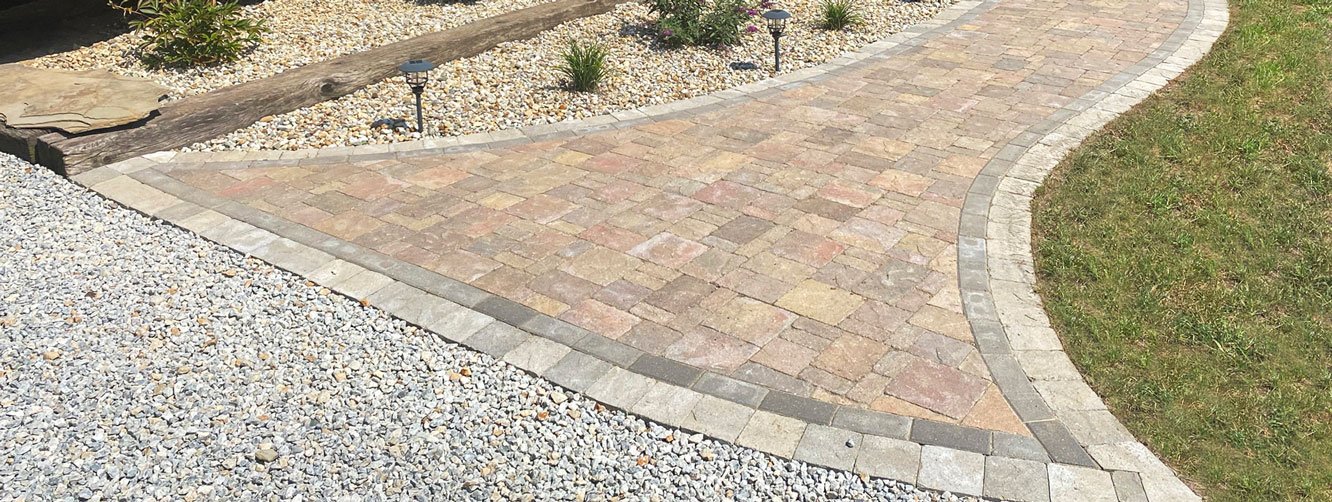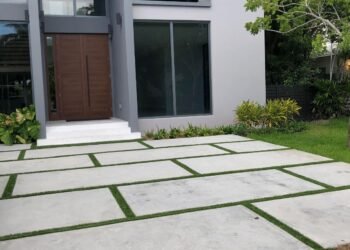Slabs of concrete that are formed to give an appealing look to stone, brick, wood, tile and other patterns are known as stamped concrete.
There are innumerable stamped concrete patio ideas around you. A unique outdoor space can be created by using the stamped concrete on your patios. Impersonate your stamped concrete floor by bringing a brick, stone, or any other finish as per your imagination.
Stamped concrete patios are affordable, durable, and easy to maintain, can be customized, and are available in numerous options. A few good stamped concrete patio ideas are:
Natural Stone Textured

Also Read: Reasons to Choose Natural Stone Pavers Over Concrete Pavers
Stone-like stamped concrete is obtained by stamping a shape that duplicates the appearance and shape of natural stone on the surface of fresh concrete. Depending on the type of stone you purchase and how you use it. The stone effect of stamped concrete gives the surface an aesthetic quality. The patios are designed with great visual power. A material with proven resistance and durability that doesn’t go unnoticed is natural stone textured concrete.
Wood Grain Finish

Renovated patio concrete painted with brown aging stains to mimic the look of wood. A finished stain look is created on the concrete surface, giving it a simple and accurate wood grain effect. You can modify your floor by allowing a wood finish to your patio concrete without the trouble of maintaining an actual wooden floor. The outcome is a distinct and charming patio.
Brick Patterns

Brick Pattern is a decorative concrete that gives your patios a precision floor design. Brick Patterns concrete stamps are durable and long-lasting, ensuring a stunning patio floor.
They are an ideal choice for your patio, giving us versatile and remarkable flooring.
Cobblestone Appeal

Paving creates a distinct style and texture. Cobblestone Appeal is the most common design option for a concrete base. This pattern provides excellent adhesion to the concrete surface. It is perfect for outdoor concrete that can be used in your driveway and patios.
Herringbone Design

One direction Parallel line columns refer to the herringbone design on your concrete patio. Pairing these adjacent to each other gives a sloping view of your patio floors.
Stained Concrete

Stained concrete is concrete that has been dyed to a different color. It can be opaque or transparent, glossy or matte, solid or shadow. Staining concrete can transform your patio into an industrial look that’s elegant or cozy, depending on the colors and finishes you choose.
More and more people are choosing stained concrete because it is cost-effective and has limitless creativity. Boundless colors and combinations are available in stained concrete, giving your patios a timeless and artful patio floor.
Seamless Slate

Textured surfaces, also known as seamless concrete stamps, are feather-edge stamping tools that can be rotated and overlapped to change the texture endlessly. Texture style can be used to correct and complement structured textures, or they can be used as the primary means of creating a striking continuous texture. It brings functionality and durability to your patio floors. An earthy atmosphere is created with the natural cracking floors.
Incorporate Borders

Concrete edge borders are used for patio flooring that provides a decorative and printable appearance. Incorporating borders around your garden gives a finished look that you are looking for.
Because of its versatility, homeowners prefer to use concrete borders as a base material when building a patio. It comes in different shades and textures to imitate the border surface.
Outdoor Rug Illusion

The high-contrast linear effects and unexpected patterns, even illustrative elements. Concrete gray, coral red and dirty yellow stand out against the eye-catching outdoor rug illusion patterns.
Neutral bases support the bold use of color and shape. Give your patio area a cheerful atmosphere by decorating the place with a concrete illusion rug. These unique designs offer abstract and contemporary patterns that play on the mind, creating the illusion of a patio floor falling.
Geometric Patterns

Geometric pattern includes objects, shapes, images, or other repeating elements. This repetition can be regular and obvious, like repeating squares in a grid, or more irregular or asymmetrical, creating a more abstract-looking pattern to your patio concrete floors.
Shapes include squares, rectangles, triangles, hexagons, diamonds, and more, giving a visual depth and intrigue that can be as subtle or bold as a modern look to your home patio floors.
Blended Patterns

The natural or nature-inspired blended patterns of the concrete patio floors, such as veins, spots, and grains, encourage visual stimulation and movement in the space. Some appear to resemble waves or a wood grain pattern, while others have a subtle concrete effect.
Mixing solids and patterns on surrounding surfaces can provide balance and form, but before you begin, create a successful design scheme by mixing tiles and tile patterns into complementary patterns. For example, try combining a concrete floor sample with brighter materials such as natural stone or wood-look tile. A minimalist patio space can benefit from blended patterns on the surface.
Conclusion
Also Read: 18 Inspiring Modern Concrete Patio Ideas For Your Home
A low-maintenance, durable stamped concrete patio is the perfect base for outdoor living where you can both relax and entertain. Stamped concrete offers a wide variety of patterns and textures. An elegant, modern and versatile selection of concrete stamps offers a brilliant range of designs and colors for your patio floors.
FAQ
What is the most popular color for stamped concrete?
Brown and Beige are the most popular earthy colors for stamped concrete.
What is the downside to concrete pavers?
The downside to concrete pavers is that they show damage in very cold conditions, and repairing them can be difficult.
What is the most popular stamped concrete pattern?
Flagstone is the timeless and most popular concrete pattern for your patio.
Do concrete pavers crack easily?
Concrete pavers don’t crack so easily and are less vulnerable.









